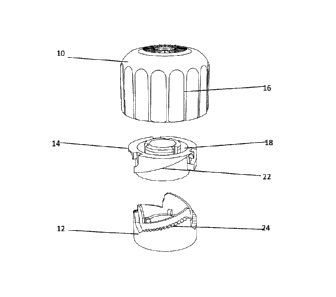Une partie des informations de ce site Web a été fournie par des sources externes. Le gouvernement du Canada n'assume aucune responsabilité concernant la précision, l'actualité ou la fiabilité des informations fournies par les sources externes. Les utilisateurs qui désirent employer cette information devraient consulter directement la source des informations. Le contenu fourni par les sources externes n'est pas assujetti aux exigences sur les langues officielles, la protection des renseignements personnels et l'accessibilité.
L'apparition de différences dans le texte et l'image des Revendications et de l'Abrégé dépend du moment auquel le document est publié. Les textes des Revendications et de l'Abrégé sont affichés :
| (12) Brevet: | (11) CA 2827667 |
|---|---|
| (54) Titre français: | DISPOSITIF DE REGLAGE DE NIVEAU POUR MEUBLES |
| (54) Titre anglais: | FURNITURE LEVELLING DEVICE |
| Statut: | Réputé périmé |
| (51) Classification internationale des brevets (CIB): |
|
|---|---|
| (72) Inventeurs : |
|
| (73) Titulaires : |
|
| (71) Demandeurs : |
|
| (74) Agent: | MOFFAT & CO. |
| (74) Co-agent: | |
| (45) Délivré: | 2018-11-20 |
| (86) Date de dépôt PCT: | 2012-02-16 |
| (87) Mise à la disponibilité du public: | 2012-08-23 |
| Requête d'examen: | 2017-02-08 |
| Licence disponible: | S.O. |
| (25) Langue des documents déposés: | Anglais |
| Traité de coopération en matière de brevets (PCT): | Oui |
|---|---|
| (86) Numéro de la demande PCT: | PCT/ZA2012/000008 |
| (87) Numéro de publication internationale PCT: | WO2012/112996 |
| (85) Entrée nationale: | 2013-08-16 |
| (30) Données de priorité de la demande: | ||||||
|---|---|---|---|---|---|---|
|
L'invention concerne un dispositif destiné à régler la longueur utile d'un pied de table. Le dispositif comprend des éléments supérieur et inférieur (10, 12, 14) associés l'un à l'autre de façon tournante et sont sollicités dans le sens de l'écartement par des moyens élastiques (20), l'élément supérieur (14) comprenant une première rampe descendante (22) espacée par rapport à une deuxième rampe à rochet (24) associée à l'élément inférieur (12) par une paroi. L'élément supérieur (10) comprend un ou plusieurs cliquets (25) conçus pour circuler dans la rainure entre les rampes (22, 24), et comprenant une formation conçue pour coopérer avec le rochet lorsque la longueur utile souhaitée du pied et du dispositif combinée a été réglée.
The invention provides a device for adjusting the effective length of a table
leg. The device
includes an upper and a lower member (10, 12, 14) that is rotatably associated
with one
another and are biased apart by spring means (20), the upper member (14)
including a first
downwardly directed ramp (22) spaced apart from a second ratchet ramps (24)
associated
with the lower member (12) by a wall. The upper member (10) includes one or
more pawls
(25) adapted to run in the channel between the ramps (22, 24), and including a
formation
adapted to engage the ratchet when the desired effective length of the leg
plus device has
been adjusted.
Note : Les revendications sont présentées dans la langue officielle dans laquelle elles ont été soumises.
Note : Les descriptions sont présentées dans la langue officielle dans laquelle elles ont été soumises.

Pour une meilleure compréhension de l'état de la demande ou brevet qui figure sur cette page, la rubrique Mise en garde , et les descriptions de Brevet , États administratifs , Taxes périodiques et Historique des paiements devraient être consultées.
| Titre | Date |
|---|---|
| Date de délivrance prévu | 2018-11-20 |
| (86) Date de dépôt PCT | 2012-02-16 |
| (87) Date de publication PCT | 2012-08-23 |
| (85) Entrée nationale | 2013-08-16 |
| Requête d'examen | 2017-02-08 |
| (45) Délivré | 2018-11-20 |
| Réputé périmé | 2020-02-17 |
Il n'y a pas d'historique d'abandonnement
| Type de taxes | Anniversaire | Échéance | Montant payé | Date payée |
|---|---|---|---|---|
| Le dépôt d'une demande de brevet | 200,00 $ | 2013-08-16 | ||
| Taxe de maintien en état - Demande - nouvelle loi | 2 | 2014-02-17 | 50,00 $ | 2014-02-14 |
| Taxe de maintien en état - Demande - nouvelle loi | 3 | 2015-02-16 | 50,00 $ | 2015-01-19 |
| Taxe de maintien en état - Demande - nouvelle loi | 4 | 2016-02-16 | 50,00 $ | 2016-02-15 |
| Taxe de maintien en état - Demande - nouvelle loi | 5 | 2017-02-16 | 100,00 $ | 2017-02-01 |
| Requête d'examen | 400,00 $ | 2017-02-08 | ||
| Taxe de maintien en état - Demande - nouvelle loi | 6 | 2018-02-16 | 100,00 $ | 2018-02-14 |
| Taxe finale | 150,00 $ | 2018-10-05 | ||
| Taxe de maintien en état - brevet - nouvelle loi | 7 | 2019-02-18 | 100,00 $ | 2019-02-11 |
Les titulaires actuels et antérieures au dossier sont affichés en ordre alphabétique.
| Titulaires actuels au dossier |
|---|
| GILD, KEITH |
| Titulaires antérieures au dossier |
|---|
| S.O. |